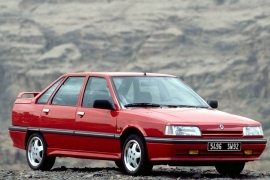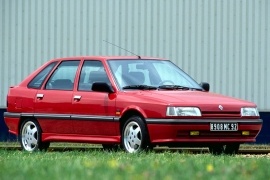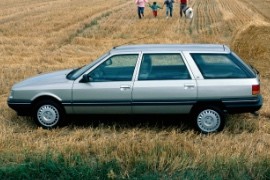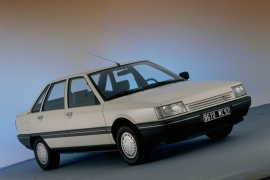RENAULT 21 Models/Series Timeline, Specifications & Photos
First production year: 1986
Engines: Gasoline, Diesel
Renault introduced a refreshed version of the 21 range in 1989, just three years after it introduced the new model on the European market.
Strangely, the carmaker unveiled the 21 in autumn 1985, but the sales started in 1986. In the following year, it sent it to the U.S. re-badged as Eagle Medalion. But Renault considered that the car deserved a visual upgrade, considering that it was sold in big numbers and it was available in various countries.
The 21 featured a different front fascia. Its edges were shaved and made rounder, while the upgraded headlights got wider. Renault installed a body-colored wrapped around bumper instead of the black one used before. For the Turbo version, the carmaker added a lower apron with a set of yellow fog lights.
Inside, the 21 featured a new dashboard. It was still wedged-shaped, but its instrument cluster was taller than the rest of the dash panel. On the upper side of the center stack, the carmaker placed the stereo, while on the lower side, under a set of center vents, it installed the climate control sliders. Depending on the engine and trim level, the 21 sported high-bolstered seats, while most of the range received just regular bucket seats.
Under the hood, Renault played an expensive card of longitudinal and transverse-mounted engines. Power ranged between 65 hp and 162 hp, and there was a new, 1.9-liter diesel unit.
Renault refreshed the model 21 lineup in 1989, marking a mid-life cycle refresh for the mid-size vehicle.
The French carmaker revealed the model 21 in late 1985 and refreshed the lineup just three years later. It sold it also on the North American continent badged as Eagle Medallion, but only in the three-box sedan version. For other countries, it produced it as a liftback version as well. Thus, it was halfway between the sedan and the station wagon version.
The 21 featured a different front fascia. Its edges were shaved and made rounder, while the upgraded headlights got wider. In addition, Renault installed a body-colored wrapped around bumper instead of the black one used before. Like its three-box sedan sibling, the hatchback featured an additional small side window behind the rear doors, but with a thicker D-pillar and a tailgate. The wide taillights sported a darkened lower side while the upper red area was connected with a red stripe that ran above the license plate.
Inside, the 21 featured a new dashboard. It was still wedged-shaped, but its instrument cluster was taller than the rest of the dash panel. On the upper side of the center stack, the carmaker placed the stereo, while on the lower side, under a set of center vents, it installed the climate control sliders. The hatchback version featured a folding seatback for the rear seats, which expanded the trunk from 420 liters (14.8 cu-ft) to 1,290 liters (45.6 cu-ft).
Under the hood, Renault played an expensive card of longitudinal and transverse-mounted engines. Power ranged between 65 hp and 162 hp, and there was a new, 1.9-liter diesel unit.
In the mid-late 80s, Renault had to replace its aging model, the 18, which was still based on original 1960s technologies. With help from the Italdesign Giugiaro design studio, Renault made the Renault 21 in 1986 and, a few months later, in 1987, the station wagon version was launched. There were a lot of station wagons in those times. So, in order to differentiate itself from competitors, the Renault 21 Nevada came up with a seven-seat solution, but those two extra seats were eating into the trunk space and were suitable only for children up to 10 years old.
The 80s were the years when longitudinal and transverse engine fans were fighting, and engineers of both sides were struggling to impose their point of view. This is why some versions of the Renault 21 were available with transverse units and the higher displacement engines were longitudinal. The smaller engines had a 1.7-liter displacement, but they went up to 2.2-liter turbodiesel engines.
The power ranged between 75 and 136 hp. It was also available with a permanent all-wheel-drive system, but not too many were ordered with this type of unusual, then, traction. The transmission was a 5-speed manual as standard. The 4-speed automatic transmission was available as an option on certain engine variants. Air conditioning was offered on some trim levels.
The Renault 21 was a mid-size vehicle built by the French car-maker. It was offered as a 4-door sedan, 5-door hatchback, or a station-wagon. It was sold in the U.S. as a Renault or Eagle Medallion.
The once-successful Renault 18 started to show its age and the sales started to drop. The French car-maker had to replace it and the answer was of two vehicles instead of one. The Renault 18 was replaced by the 19 and by the 21. Both ranges covered more than the 18 ever could. The ascending demand for compact-segment customers was diverted to the 19 and those who were looking for something bigger were attracted by the 21 model.
The Renault 21 came in three shapes, with up to seven seats for the station-wagon version. It was designed by Giorgetto Giugiaro, the same mastermind that draws other successful vehicles for Lamborghini, Volkswagen, or Cadillac. An interesting feature for those times was the third side window installed behind the rear doors.
Inside, the Renault 21 featured a flat dashboard with an angular look that followed the exterior design language. It featured manual or automatic transmission, air-conditioning, power windows and brakes, and few choices for the stereo system.
Under the hood, the 21 featured an unusual configuration: the smaller engines were installed transversely while the powerful models were fitted with longitudinally-mounted units. Most of the R21 featured front-wheel-drive systems, but some models were all-wheel-drive.



